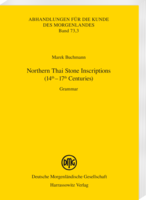more titles of the subject:
Download:
Please note: With adding digital Products to your cart
the payment will be handled via PayPal. The download will be provided after the payment is confirmed. The present volume represents the third and ?nal part of Marek Buchmann’s study of northern Thai stone inscriptions from the 14th to the 17th century. It is intended to give a preliminary grammatical overview of epigraphic Lanna Thai in Fak Kham script and is part of a series consisting of an epigraphic glossary and a catalog of inscriptions, published as AKM 73,1 and AKM 73,2, respectively. The grammar serves as an aid to better understand the vocabulary in its inscriptional context. It consists of three main parts: phonology and orthography, syntax, and lexicon. The appendix offers detailed lists of grammatical terms and additional tables, which are a very useful aid for the reading of time and date in inscriptions. The vocabulary of the northern Thai stone inscriptions corpus is con?ned to one group of texts only and covers a well-de?ned, limited historical time range. Nevertheless, the grammar may also serve as an aid for the interpretation of other contemporaneous Thai texts of other regions. Even though this book can be used independently, it may still require consulting the Catalogue (AKM 73,2) for complete references to all available texts, images, rubbings or the location of cited inscriptions as original source. And although interlinear glosses have been provided in the text samples appearing in this volume, the reader may still wish to consult the Glossary (AKM 73,1) for more detailed lexical information.
|
||||||||||||||||||||||||||||||||||||||||||






